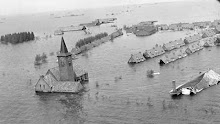Life list now 201 species
>>Not only waders!
Following the just-described adventures with waders on the Salt Pans, I saw several different kinds of migrant passerines (song birds), during the period 25 April to 30 May 1946. Here is my account of my encounters during that period with one family, the Shrikes, and, for comparison, what previous observers had written about them. >>>
30 April 1946, Salt Pans. Near the main road “I found a party of shrikes. There were half-a dozen altogether and I first noticed them on and in rolls of barbed wire. They dispersed upon my arrival and perched at various spots including the telegraph wires. One of them was a Lesser Grey Shrike * Lanius minor. The size was just greater than that of a Red-backed Shrike nearby. The most noticeable characteristic was the pinkish breast, white throat, upperparts grey, forehead, lores and behind eye black (no white over eye), bill and legs black. No black was seen on the belly. The wings were black and grey with a wide and noticeable white bar in flight. From the data, I cannot say if it was ♂ or ♀ [probably ♂ by the grey upperparts and pinkish breast]. The Red-backed Shrikes Lanius collurio were not quite as in England, one or two having a white wing bar for instance [The latter were probably Isabelline Shrikes Lanius isabellinus, a species I was as yet not aware of.] There were definite ♀ of this species (even barring etc. seen on the breast.)” On 3 May in the Settlement Gardens, Sheikh Othman, there was “a ♂ Red-backed Shrike (?). It had no white stripe over the eye and all of underparts except white chin and throat were ‘pinkish buff’. The back seemed, though of a richer brown than usual [i.e. as in England], not to be really rufous.” I found more shrikes on 6 May between Khormaksar airfield and the mud flats. “Along a section of the barbed wire fence I estimated c.10 ♂ and c.5 ♀ Red-backed Shrikes (?) I noticed a ♀ approach a ♂ sitting on a pile of b. wire, and fluttered 4-6 feet from him, calling “tsack”. This was continued for about 5 seconds. The ♂ appeared completely unmoved. On another section of the fence there were three Lesser Grey Shrikes”
>>These excerpts from Ibis show that my records of Lesser Grey Shrikes were the first for Aden and hence my fifth addition to the Aden list . These records were even more notable for, according to Meinertzhagen's 1954 book The Birds of Arabia, the Lesser Grey Shrike had never been reported in the whole of Arabia on spring migration (though noted in the autumn). From its breeding (orange) and winter (blue) ranges shown in the accompanying map, it would be expected in Arabia on both passages. Meinertzhagen's non-acceptance of my records was a blow, and the start of my apprehensive disagreements with him, for he was a highly respected authority. I subsequently learned that Steve Norris noted the Lesser Grey Shrike in Aden in spring 1952 and Paige (1960) in early May 1958. Such confirmation increased my confidence that I had been right and was repeated, as will be elaborated in other posts. Still, I never expected that Meinertzhagen would be exposed as one of the worst ornithological fraudsters in history.
. These records were even more notable for, according to Meinertzhagen's 1954 book The Birds of Arabia, the Lesser Grey Shrike had never been reported in the whole of Arabia on spring migration (though noted in the autumn). From its breeding (orange) and winter (blue) ranges shown in the accompanying map, it would be expected in Arabia on both passages. Meinertzhagen's non-acceptance of my records was a blow, and the start of my apprehensive disagreements with him, for he was a highly respected authority. I subsequently learned that Steve Norris noted the Lesser Grey Shrike in Aden in spring 1952 and Paige (1960) in early May 1958. Such confirmation increased my confidence that I had been right and was repeated, as will be elaborated in other posts. Still, I never expected that Meinertzhagen would be exposed as one of the worst ornithological fraudsters in history.
Red-backed Shrikes had been reported before on migration by Meinertzhagen in April 1922 and were also observed by Paige in April-May 1958 and Clarke in May 1961. Later in the blog I will report my observations in Aden on other species of shrike, including all those mentioned above.
These passages highlight the importance given by previous observers in Aden to obtaining specimens of birds. Their motto was:
Red-backed Shrikes had been reported before on migration by Meinertzhagen in April 1922 and were also observed by Paige in April-May 1958 and Clarke in May 1961. Later in the blog I will report my observations in Aden on other species of shrike, including all those mentioned above.
These passages highlight the importance given by previous observers in Aden to obtaining specimens of birds. Their motto was:
When I arrived in 1946, I did not have any means of following this old procedure: no gun, no way to preserve specimens. I had no camera. Modern tools such as mist nets with which to catch birds and field guides for identification had not yet arrived on the scene. The only means I had of authenticating my records was of writing down and sketching what I observed. Hence the wealth of descriptive detail and diagrams in my notes, which may strike a modern reader, who does not know the reasons, as strange and unnecessary. >>>






